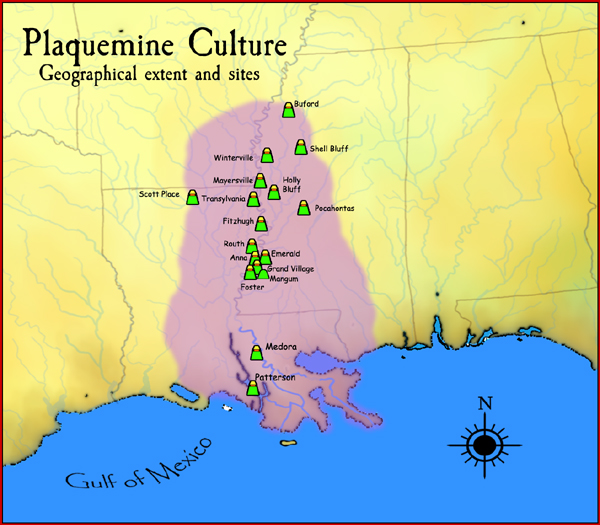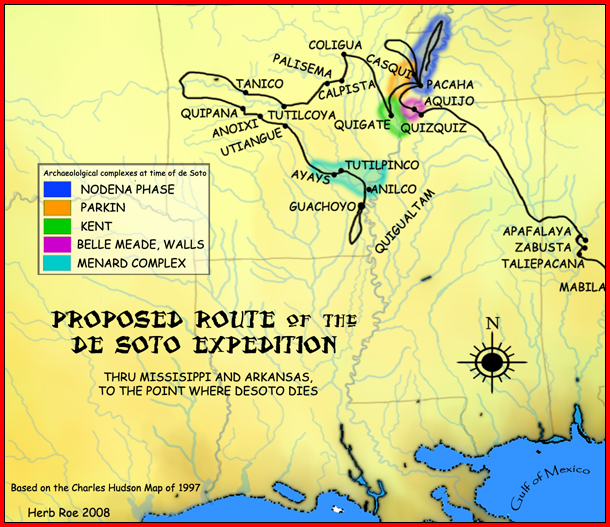|
Toltec Mounds State Park
Plum Bayou Mounds Archeological State Park ( 3 LN 42), (formerly known as "Toltec Mounds Archeological State Park") also known as Knapp Mounds, Toltec Mounds site or Toltec Mounds, is an archaeological site from the Late Woodland period in Arkansas that protects an 18-mound complex with the tallest surviving prehistoric mounds in Arkansas. The site is on the banks of Mound Lake, an oxbow lake of the Arkansas River. It was occupied by its original inhabitants from 600 to 1050 CE. The site is designated as a National Historic Landmark. Name The identification of the site with the Toltec of Mexico was a 19th-century mistake. It was thought that the Toltec people lived in North America and built the mounds. Mary Eliza Feild Officer Knapp was the co-owner of the land from 1849 to 1905. She and her first husband purchased the land in 1849 and the land passed to her after his death. She and her second husband made subsequent land purchases near the site. Mary was interested in archeol ... [...More Info...] [...Related Items...] OR: [Wikipedia] [Google] [Baidu] |
Scott, Arkansas
Scott is an unincorporated community and census-designated place (CDP) in Lonoke and Pulaski counties in the central part of the U.S. state of Arkansas. Per the 2020 census, the population was 97. It is part of the Little Rock–North Little Rock– Conway Metropolitan Statistical Area. Geography Scott is located in western Lonoke County and eastern Pulaski County at . It is bordered to the west by the city of North Little Rock. U.S. Route 165 passes through the community, leading northwest approximately to Interstate 440 and southeast to Keo. Downtown Little Rock is west of Scott. Arkansas Highway 161 runs concurrently with the Lonoke-Pulaski county line in the community, progressing northward to U.S. Route 70 and southeast to England, by way of farming areas in southeast Pulaski County. According to the United States Census Bureau, the Scott CDP has a total area of , of which are land and (4.52%) are water. The CDP's portion in Pulaski County is bisected by Hors ... [...More Info...] [...Related Items...] OR: [Wikipedia] [Google] [Baidu] |
Smithsonian Institution
The Smithsonian Institution ( ), or simply the Smithsonian, is a group of museums and education and research centers, the largest such complex in the world, created by the U.S. government "for the increase and diffusion of knowledge". Founded on August 10, 1846, it operates as a trust instrumentality and is not formally a part of any of the three branches of the federal government. The institution is named after its founding donor, British scientist James Smithson. It was originally organized as the United States National Museum, but that name ceased to exist administratively in 1967. Called "the nation's attic" for its eclectic holdings of 154 million items, the institution's 19 museums, 21 libraries, nine research centers, and zoo include historical and architectural landmarks, mostly located in the District of Columbia. Additional facilities are located in Maryland, New York, and Virginia. More than 200 institutions and museums in 45 states,States without Smithsonian ... [...More Info...] [...Related Items...] OR: [Wikipedia] [Google] [Baidu] |
Natchez People
The Natchez (; Natchez pronunciation ) are a Native American people who originally lived in the Natchez Bluffs area in the Lower Mississippi Valley, near the present-day city of Natchez, Mississippi in the United States. They spoke a language with no known close relatives, although it may be very distantly related to the Muskogean languages of the Creek Confederacy.Geoffrey Kimball, "Natchez" in ''Native Languages of the Southeastern United States'', ed. Janine Scancarelli and Heath ... [...More Info...] [...Related Items...] OR: [Wikipedia] [Google] [Baidu] |
Taensa
The Taensa (also Taënsas, Tensas, Tensaw, and ''Grands Taensas'' in French) were a Native American people whose settlements at the time of European contact in the late 17th century were located in present-day Tensas Parish, Louisiana. The meaning of the name, which has the further spelling variants of ''Taenso'', ''Tinsas'', ''Tenza'' or ''Tinza'', ''Tahensa'' or ''Takensa'', and ''Tenisaw'', is unknown. It is believed to be an autonym. The Taensa should not be confused with the Avoyel (or Avoyelles), known by the French as the ''petits Taensas'' (English: Little Taensa), who were mentioned in writings by explorer Pierre Le Moyne d'Iberville in 1699. The Taensa are more closely related to the Natchez people and both are considered descendants of the late prehistoric Plaquemine culture. The Taensa migrated as a result of Chickasaw and Yazoo hostilities, first lower down the Mississippi River. In 1715, protected by the French, they migrated to lands near the now eponymously nam ... [...More Info...] [...Related Items...] OR: [Wikipedia] [Google] [Baidu] |
Platform Mound
Platform may refer to: Technology * Computing platform, a framework on which applications may be run * Platform game, a genre of video games * Car platform, a set of components shared by several vehicle models * Weapons platform, a system or structure that carries weapons * Web platform * Platform economy (or Platform capitalism, Platformization), a structure of internet business Physical objects and features * Carbonate platform, a type of sedimentary body * Cargo platform, a pallet used to ship cargo and heavy machines by forklift or manual lift * Diving platform, used in diving * Jumping platform, naturally occurring platforms, or platforms made in an ''ad hoc'' way for cliff jumping * Oil platform, a structure built for oil production * Platform, a component of scaffolding * Platform (geology), the part of a continental craton that is covered by sedimentary rocks * Platform (shopping center) in Culver City, Greater Los Angeles, California * Theatre platform, a standa ... [...More Info...] [...Related Items...] OR: [Wikipedia] [Google] [Baidu] |
Fourche Maline Culture
Fourche ( ) is a town in Perry County, Arkansas, United States. The population was 59 at the 2000 census. It is part of the Little Rock–North Little Rock– Conway Metropolitan Statistical Area. Geography Fourche is located at (34.993192, -92.618974). According to the United States Census Bureau, the town has a total area of 0.5 km2 (0.2 mi2), all land. Demographics As of the census of 2000, there were 59 people, 23 households, and 16 families residing in the town. The population density was 119.9/km2 (303.5/mi2). There were 25 housing units at an average density of 50.8/km2 (128.6/mi2). The racial makeup of the town was 94.92% White and 5.08% Black or African American. There were 23 households, out of which 52.2% had children under the age of 18 living with them, 60.9% were married couples living together, 8.7% had a female householder with no husband present, and 26.1% were non-families. 21.7% of all households were made up of individuals, and 8.7% had ... [...More Info...] [...Related Items...] OR: [Wikipedia] [Google] [Baidu] |
Coles Creek Culture
Coles Creek culture is a Late Woodland archaeological culture in the Lower Mississippi valley in the Southeastern Woodlands. It followed the Troyville culture. The period marks a significant change in the cultural history of the area. Population increased dramatically and there is strong evidence of a growing cultural and political complexity, especially by the end of the Coles Creek sequence. Although many of the classic traits of chiefdom societies are not yet manifested, by 1000 CE the formation of simple elite polities had begun. Coles Creek sites are found in Arkansas, Louisiana, and Mississippi. It is considered ancestral to the Plaquemine culture. Features The Coles Creek culture is an indigenous development of the Lower Mississippi Valley that took place between the terminal Woodland period and the later Plaquemine culture period. The period is marked by the increased use of flat-topped platform mounds arranged around central plazas, more complex political institutions, and ... [...More Info...] [...Related Items...] OR: [Wikipedia] [Google] [Baidu] |
Ozark Mountains
The Ozarks, also known as the Ozark Mountains, Ozark Highlands or Ozark Plateau, is a physiographic region in the U.S. states of Missouri, Arkansas, Oklahoma and the extreme southeastern corner of Kansas. The Ozarks cover a significant portion of northern Arkansas and most of the southern half of Missouri, extending from Interstate 40 in central Arkansas to Interstate 70 in central Missouri. There are two mountain ranges in the Ozarks: the Boston Mountains of Arkansas and the St. Francois Mountains of Missouri. Buffalo Lookout, the highest point in the Ozarks, is located in the Boston Mountains. Geologically, the area is a broad dome with the exposed core in the ancient St. Francois Mountains. The Ozarks cover nearly , making it the most extensive highland region between the Appalachians and Rockies. Together with the Ouachita Mountains, the area is known as the U.S. Interior Highlands. The Salem Plateau, named after Salem, Missouri, makes up the largest geologic area of th ... [...More Info...] [...Related Items...] OR: [Wikipedia] [Google] [Baidu] |
White River (Arkansas)
White River may refer to: Bodies of water Africa * Bakoy River, in West Africa, called the White River over a portion of its length Canada * White River (British Columbia) * White River (Vancouver Island), a river in the Discovery Passage–Johnstone Strait watersheds of British Columbia ** White River Provincial Park * White River (Nass River), a river in the Marcus Passage watershed of British Columbia * White River (Quebec) * White River (Yukon) The White River (french: Rivière Blanche) ( Hän: ''Tadzan ndek'') is a tributary about long, of the Yukon River in the U.S. state of Alaska and the Canadian territory of Yukon. The Alaska Highway [Baidu] |
Quapaw
The Quapaw ( ; or Arkansas and Ugahxpa) people are a tribe of Native Americans that coalesced in what is known as the Midwest and Ohio Valley of the present-day United States. The Dhegiha Siouan-speaking tribe historically migrated from the Ohio Valley area to the west side of the Mississippi River in what is now the state of Arkansas; their name for themselves (or autonym) refers to this migration and to traveling downriver. The Quapaw are federally recognized as the Quapaw Nation. The US federal government forcibly removed them to Indian Territory in 1834, and their tribal base has been in present-day Ottawa County in northeastern Oklahoma. The number of members enrolled in the tribe was 3,240 in 2011. Name Algonquian-speaking people called the Quapaw ''akansa''. French explorers and colonists learned this term from Algonquians and adapted it in French as ''Arcansas''. The French named the Arkansas River and the territory of Arkansas for them. Government The Quapaw Natio ... [...More Info...] [...Related Items...] OR: [Wikipedia] [Google] [Baidu] |
Archaic Period In The Americas
Archaic is a period of time preceding a designated classical period, or something from an older period of time that is also not found or used currently: *List of archaeological periods **Archaic Sumerian language, spoken between 31st - 26th centuries BC in Mesopotamia (Classical Sumerian is from 26th - 23rd centuries BC). **Archaic Greece **Archaic period in the Americas **Early Dynastic Period of Egypt * Archaic Homo sapiens, people who lived about 300,000 to 30,000 B.P. (this is far earlier than the archaeological definition) * Archaism, speech or writing in a form that is no longer current * Archaic language, one that preserves features that are no longer present in other languages of the same language family *List of archaic musical instruments This is a list of medieval musical instruments as used in European music. List References External links''Zampogne e Ciaramella'' {{DEFAULTSORT:Medieval musical instruments Medieval In the history of Europe ... [...More Info...] [...Related Items...] OR: [Wikipedia] [Google] [Baidu] |





